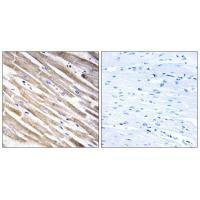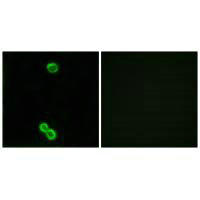Description
| Antibody Name: | RPL3L Antibody (PACO23370) |
| Antibody SKU: | PACO23370 |
| Size: | 100ul |
| Host Species: | Rabbit |
| Tested Applications: | ELISA, IHC, IF |
| Recommended Dilutions: | ELISA:1:2000-1:10000, IHC:1:50-1:100, IF:1:100-1:500 |
| Species Reactivity: | Human |
| Immunogen: | Synthesized peptide derived from internal of human RPL3L. |
| Form: | Liquid |
| Storage Buffer: | Rabbit IgG in phosphate buffered saline (without Mg2+ and Ca2+), pH 7.4, 150mM NaCl, 0.02% sodium azide and 50% glycerol. |
| Purification Method: | The antibody was affinity-purified from rabbit antiserum by affinity-chromatography using epitope-specific immunogen. |
| Clonality: | Polyclonal |
| Isotype: | IgG |
| Conjugate: | Non-conjugated |
 | Immunohistochemistry analysis of paraffin-embedded human heart tissue using RPL3L antibody. |
 | Immunofluorescence analysis of MCF-7 cells, using RPL3L antibody. |
| Background: | This gene encodes a protein that shares sequence similarity with ribosomal protein L3. The protein belongs to the L3P family of ribosomal proteins. Unlike the ubiquitous expression of ribosomal protein genes, this gene has a tissue-specific pattern of expression, with the highest levels of expression in skeletal muscle and heart. It is not currently known whether the encoded protein is a functional ribosomal protein or whether it has evolved a function that is independent of the ribosome. |
| Synonyms: | 60S ribosomal protein L3-like; |
| UniProt Protein Function: | RPL3L: a protein that shares sequence similarity with ribosomal protein L3. The protein belongs to the L3P family of ribosomal proteins. Unlike the ubiquitous expression of ribosomal protein genes, this gene has a tissue-specific pattern of expression, with the highest levels of expression in skeletal muscle and heart. It is not currently known whether the encoded protein is a functional ribosomal protein or whether it has evolved a function that is independent of the ribosome. [provided by RefSeq, Jul 2008]Protein type: Ribosomal; TranslationChromosomal Location of Human Ortholog: 16p13.3Cellular Component: membrane; ribosome; cytosolMolecular Function: structural constituent of ribosome; RNA bindingBiological Process: SRP-dependent cotranslational protein targeting to membrane; cellular protein metabolic process; translational elongation; translation; viral reproduction; mRNA catabolic process, nonsense-mediated decay; translational initiation; viral transcription; gene expression; viral infectious cycle; translational termination |
| UniProt Protein Details: | |
| NCBI Summary: | This gene encodes a protein that shares sequence similarity with ribosomal protein L3. The protein belongs to the L3P family of ribosomal proteins. Unlike the ubiquitous expression of ribosomal protein genes, this gene has a tissue-specific pattern of expression, with the highest levels of expression in skeletal muscle and heart. It is not currently known whether the encoded protein is a functional ribosomal protein or whether it has evolved a function that is independent of the ribosome. [provided by RefSeq, Jul 2008] |
| UniProt Code: | Q92901 |
| NCBI GenInfo Identifier: | 4826988 |
| NCBI Gene ID: | 6123 |
| NCBI Accession: | NP_005052.1 |
| UniProt Secondary Accession: | Q92901 |
| UniProt Related Accession: | Q92901 |
| Molecular Weight: | 46,296 Da |
| NCBI Full Name: | 60S ribosomal protein L3-like |
| NCBI Synonym Full Names: | ribosomal protein L3-like |
| NCBI Official Symbol: | RPL3L |
| NCBI Official Synonym Symbols: | |
| NCBI Protein Information: | 60S ribosomal protein L3-like |
| UniProt Protein Name: | 60S ribosomal protein L3-like |
| UniProt Synonym Protein Names: | |
| Protein Family: | 60S ribosomal protein |
| UniProt Gene Name: | RPL3L |
| UniProt Entry Name: | RL3L_HUMAN |
| Antibodies |
| RPL3L Antibody (PACO04937) |
| Secondary Antibody |
| Anti-HRP Goat Anti-Rabbit IgG (H+L) Antibody (CABS014) |
| Recommended Products |
| Anti-FITC Goat Anti-Rabbit IgG (H+L) Antibody (CABS011) |
| Anti-HRP-conjugated Beta Actin Antibody (CABC028) |






